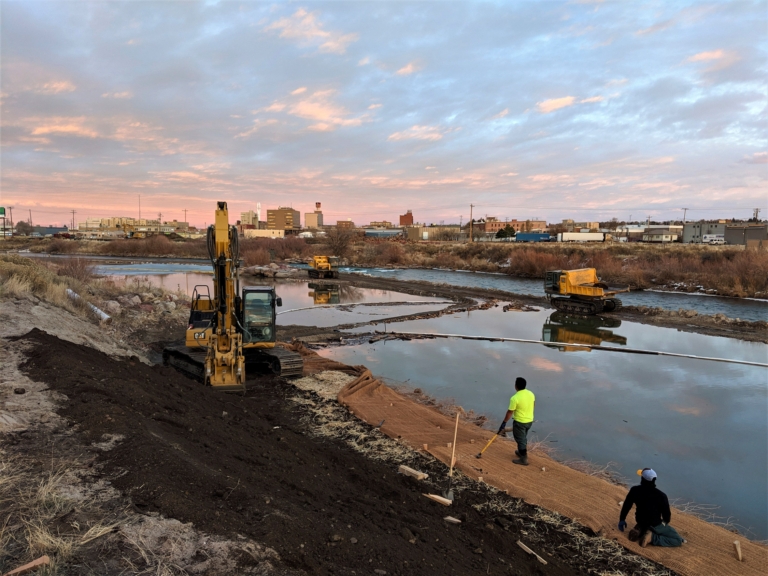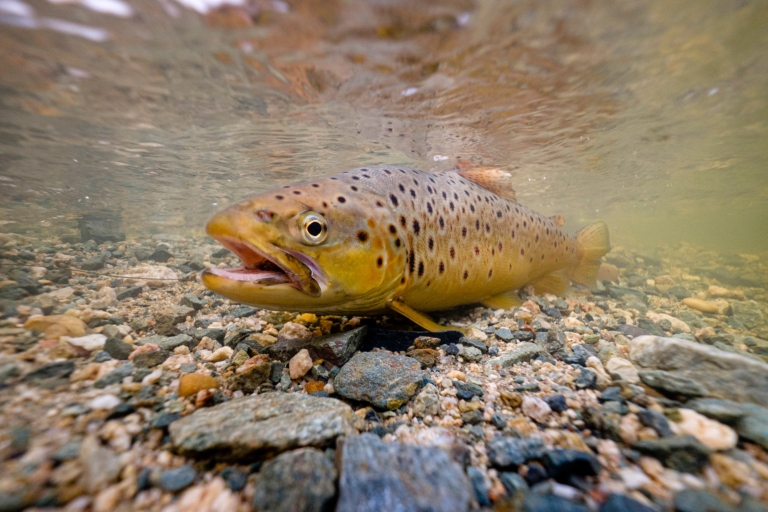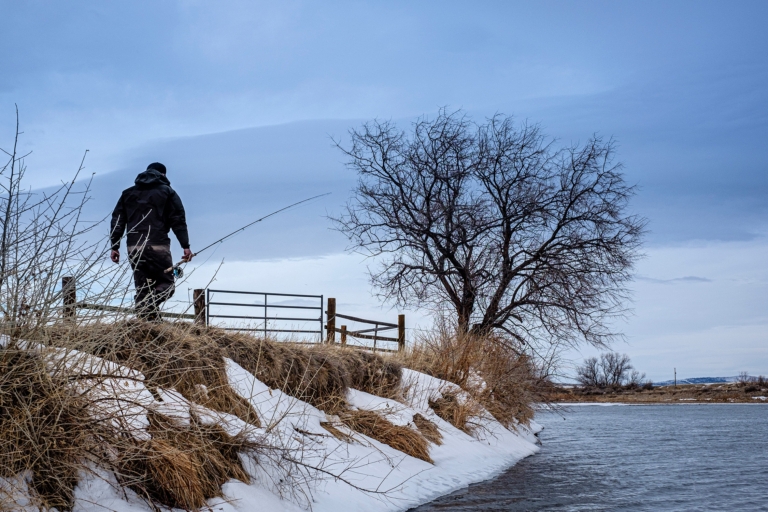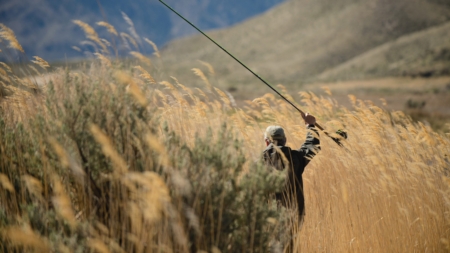It’s All Home Water: The People’s River
How Casper reimagined the North Platte.
When I first moved to Casper, Wyoming, I did what almost every eager fly angler does—I drove the 20-plus miles to the dam at Grey Reef and started flogging the obvious pools and tail-outs. I wasn’t alone that first time, or any of the thousands of times I’ve fished the Reef since. When I settled into a boxy rental on Odell Street, the Game and Fish estimated that there were up to 3,000 fish per mile in the upper sections. I knew that I had stumbled into something special by moving to Casper. But I also knew that there was a lot more to the North Platte River than the three miles of frothy water below the towering cement structure at Grey Reef.
Vaguely, I knew the shameful history of how the river was treated. Fortunes were made. But extraction industries always seem to export the lion’s share of the money elsewhere. Today there are a few austere mansions in Casper’s Big Tree Area, but the vast wealth that was pumped from the ground is merely a whisper. Like many rivers in America, the North Platte was seen as a place to dispose industrial and human waste. Fish kills, all the way downstream to Guernsey, 100 miles and beyond, were common occurrences. In fact, in 1958, a government survey determined that the North Platte near Casper was the most polluted waterway in the country.
The smart money predicted that the river would never recover, that, like so many other casualties of the West, it was lost. Though the pump jacks and storage tanks have been dismantled and hauled away, you can still discern the echo of unencumbered industrial pursuits stamped into the ground. The long, slow sections that ran through town were full of riprap and debris. The banks were caved in, sediment clogged the channel, and the riverine habitat was overgrown with Russian Olive trees, an invasive species. Rumors that large brown trout lurked within the city limits never tempted me enough to do any real investigations. As far as I was concerned, fishing in the North Platte only began well upstream of Casper. What flowed through town was degraded beyond hope, saturnine, sacrificed for profit.

Work in progress. Restoration continues on a section of the North Platte River near Casper, Wyoming. Photo: David Zoby
Quintessential Wyoming
Roughly the same time I moved to Casper, the city and its residents identified the North Platte as a major economic and cultural driver for the region. People didn’t give up on the river. They decided to do something about it. The former site of the Amoco refinery was well into its remediation plan. The Two-Fly Organization, a nonprofit that raises money through its celebrated fly fishing tournament, partnered with the city to study the viability of a complete hydrology project that would restore the river channel, stabilize the banks, create fish habitat and improve spawning areas. Invasive Russian Olives would be removed by the tens of thousands, while native shrubs and cottonwood galleries would be encouraged to take root.
What began as a modest idea of an annual river cleanup grew into a multifaceted conglomeration to overhaul seven sections of river, from city border to city border, 13.5 miles of river in total. The Platte River Revival Committee is made up of citizens who believe that the North Platte, as it flows through town, deserves a chance at redemption. One of the names that often comes up when inquiring about the project is Jolene Martinez, the assistant to the city manager.
Martinez and her group envision a natural swath of riparian habitat running through Casper. She talks about “democratizing the river.” She sees fishing the river as a birthright. She imagines a legacy of wetlands complete with migrating waterfowl and wild birds, smackdab in the middle of the city. During an interview in her office, she reminded me several times that we have Blue Ribbon trout fishing right in town, right under our noses. She showed me binders of maps, proposals and scientific studies.
“I love to go fly fishing up at the Grey Reef area. I love hiring a guide and being out there. But not everybody can afford that,” she said. “If you live in Casper, and you can purchase a fishing license and get some gear, you should be able to make your way to a public park, and not necessarily have to go to Grey Reef.” She talked about the legacy of this project. “How do we do right by the river, for Casper, for generations to come?” she asked.

Welcome to the neighborhood. The North Platte is host to big-shouldered brown trout in world-class stretches like the “Miracle Mile” and “Grey Reef.” A river restoration project hopes to add “downtown Casper” to that famously fishy list. Photo: Mark Lance
Martinez is quick to point out the many entities involved in the restorations project: Natrona County Weed and Pest, the Bureau of Land Management, the Wyoming Game and Fish Department, the National Audubon Society, the Two-Fly Foundation, the Department of Environmental Quality and, of course, the City of Casper. Bringing all of these disparate groups together for one goal, Martinez tells me, is the essence of Wyoming. To call public attention to the project, the Platte River Revival group hosts an annual river cleanup days in September that culminates in a community BBQ at Mike Lansing Field, just off the river. This year saw more than 400 volunteers.
“We’re taking all comers—we’ve never been exclusive—but we pulled in the people who had the scientific knowledge to do what we needed to do,” said Martinez.
Bulldozers in the River
Without knowing it, I have been walking atop restored riverbanks these last few years. The first section the project tackled was Morad Park, a popular off-leash dog park with well-established cottonwood galleries, groves of hawthorn and lots of river access. Using granite boulders and trees harvested from the Nordic trail on Casper Mountain, engineers built a wood toe bank structure and planted willows on top. (Wood toe is the preferred bank restoration process. It stays in place, halts erosion and provides a natural habitat for fish.) Runoff and freshets were encouraged to flow over flat, boggy sections of the park; the results are obvious wetlands. When I walk my dogs here it is not unusual to startle a pair of mallards or to annoy a gaggle of Canada geese that winter in the area. This work was completed in the summer and fall of 2016.
While tossing the training dummy for my Labs along this stretch, I’ve noticed pods of feeding trout sipping midges on late-fall afternoons. The channel restorations make the river sing. I can see clean plains of gravel where fish might spawn. And people who fish this section are reporting surprising encounters with large fish. For the first time in 20 years, I am seeing a rare drift boat, complete with clients and a taciturn guide at the sticks, drifting through this section.
But still, citizens were understandably alarmed when they spotted two huge bulldozers doing channel restoration in the section under the Poplar Street Bridge. The river restoration project came into full view in the fall of 2019, when the work began right beside the popular fast-food restaurants and other downtown attractions. While engineers had set up absorbent booms to catch any carbon residue that might seep up from the riverbed as the machines worked, citizens were suspicious. Engineers had predicted that leftover pollutants from our oily past might emerge as the work began. They planned for this, but there was more industrial waste than the project managers had anticipated. Conspiracy theories emerged. People had to be assured that the heavy machinery was not degrading the river.
On a windy day in November, I attended a press conference on the banks of the North Platte. Martinez had gathered many of the members of the river restoration project to answer questions from the press and the public. We stood in a knot in the parking lot of the Jonah Bank. There were Game and Fish reps in their red button-down shirts, hardhat-wearing project managers from Stantec, the environmental firm hired to do the restoration, and journalists and their corresponding notepads. The bulldozers were idle in the background. A few geese fed in the main channel as we gathered.
Brian Connelly, from Natrona County Weed and Pest, has a way of talking about history that makes you want to listen. He wove tales of just how devastated the river was before the restoration work began. A stout man in Rooseveltian spectacles (Teddy, not Franklin), he seemed to be enjoying himself. “If you would have shown up here in the ’70s you would have found a fairly large refinery—and, as we know, refinery landscapes are industrial. It didn’t look like someplace you wanted to walk along the river. In fact, it was just refinery access on that side of the river,” Connelly said.
“The trash was insane. There was nobody cleaning it up—there was nobody that cared. It wasn’t trout habitat by any means,” he added. Native species such as the shovel-nosed sturgeon, river redhorse, longnose sucker and the brassy minnow could not survive the vulgarities of an unchecked oil industry. They disappeared one by one.
Connelly explained that the attitudes of those times were dramatically different to our attitudes today.
Randy Walsh, the senior restoration scientist for Stantec, talked about some of the improvements the project would make, especially for fish, but for other species as well. Walsh said that large trout inhabit the downtown section of the river, but they migrate and are constantly on the move. “There was no structure. No cover. No feeding lanes,” he said.
Most of the riverbed, as it runs through town, suffered from silt buildup. There were few suitable gravel beds for trout to make their redds, these stretches didn’t feature deep pools where juvenile fish might thrive, and the entire area lacked ambush habitat where large trout can prey on smaller fish.

Eric Ishiwata heads out into a blustery winter day on the North Platte’s Grey Reef stretch searching for hungry brown trout. For Ishiwata, standard equipment in these tough conditions includes a windproof cast and one of his munchable hand-tied streamers. Photo: Mark Lance
Trout Culture
Walsh, who has worked on river restorations in Wyoming for years, always buys an annual fishing license so that he can tote his fly rod along and test the results of his projects on his days off. Walsh and I had a lot in common. Both of us had spent our 20s crisscrossing the West to catch one hatch or another. Both of us were acquainted with the trout towns that dot the map: Twin Bridges, Fort Smith, Gunnison, Dutch John. These are iconic destinations with populations that rarely exceed 400 souls. But what they lack in population, they make up for in trout culture. Drift boats slide through town each morning, anglers hang out at the local coffee roasters and breweries and public art depicts colorful fish rising to take insects off the surface.
I asked Walsh if Casper could ever be a trout town in the same manner. He said, not quite. He reminded me that Casper is the largest city in Wyoming. But that is the interesting thing about what’s happening here—Blue Ribbon trout habitat in an urban setting. He said Casper’s potential to provide a quality city fishery has no analog.
“People here understand that what they have is special and unique—you have a metropolitan area with some of the finest trout water in the country,” he said.
He told me that one of the priorities of the project was to install a new boat ramp in the middle of downtown Casper. He sees a future where anglers and guides can walk to a restaurant or brewery after a day of fishing. “I’ll know we did a good job when I come back and see a group of kids fishing in this downtown section. Then I’ll know we were successful. That will be the legacy of all of this,” he said.
Already there are measurable outcomes for the first phases of river restoration. Blake Jackson is the co-owner of the Ugly Bug Fly Shop and a longtime member of the Wyoming Flycasters, a conservation group that is involved in the North Platte River at every level.
“Since the completion of the upper stretch—Roberson Road down to the Tate Pump House—we’ve increased our guiding because the quality keeps improving. It’s cleaner; it’s more scenic; there seems to be more wildlife.”
Jackson says that we’re known for a great upstream fishery, but to add 15 to 20 miles more seems like a homerun for everyone involved. He describes these sections as being chock-full of rainbows in all sizes. But there is another reason fly fishers like these new stretches. “It’s become hunting grounds for big brown trout. My thought on it is that they’re targeting some of those smaller rainbows.”
Jackson says that the bank improvements and the structure of town acts as a windbreak and dry fly opportunities that didn’t exist years ago are now possible.“This past fall we had a phenomenal blue wing hatch coming off. When that happens in an urban setting it’s unique,” said Jackson. “If I can have people walk four blocks from my retail store and be in Blue Ribbon trout fishing—or the backdoor of their hotel—it becomes a game changer as far as the economic revenue it could lead to.”
The Heart of Wyoming
Brian Connelly and I met again in January to talk about the river over espresso at a downtown coffee house. Perhaps it was the caffine or the effects of a long winter, but both of us wanted to stretch our legs. We rumbled through town in Brian’s truck, stopping at various points of interest, such as the empty lots where thousands of beetle-killed spruce trees waited to be used in bank restoration. We stepped over some temporary fencing to get a close-up look at the sod mats and young willow saplings that would hold the new riverbanks in place. Next, we flowed across town and found ourselves at Morad.
“You won’t believe how many 12 to 14-inch fish this section holds,” he said. He said he caught a half dozen fish during a lunchbreak last spring by simply drifting a prince nymph along the restored riverbank. We were standing on a plateau that bristled with young willows and, more importantly, cottonwood saplings. I could see exposed root bundles from the wood toe construction that took place a few years ago. The river was healing itself, right there in plain view of passing traffic. Brian showed me some of the wetlands and anti-erosion structures that had been put in place. Tiny finches and juncos flashed between ancient cottonwoods. He was particularly concerned with a type of small, invasive tree called buckthorn.
“See the way the sun hits those branches and makes them look silvery? Those are native chokecherries. Buckthorn doesn’t do that,” he said. He found a likely candidate and scraped a section of bark off with a pocket knife. “Yep, that’s buckthorn. I didn’t know we had it, but we do. It will have to dealt with,” he said.
“This isn’t a one-time deal. We’re going to have to continue these projects and maintain the river. It goes on and on,” he said. There were mule deer tracks in the rinds of old snow.
We traded the usual Wyoming hunting and fishing tales. He told me about a time he was camped in Yellowstone and a downpour interrupted a dish of clams Alfredo. He and his girlfriend at the time crawled into their bags early. The next day he found grizzly bear tracks at the vestibule of tent, as if the bear was lured in by a whiff of garlic. The animal had looked in for a moment, then moved on. He said that what he loved about Wyoming is that it’s big. “I don’t mean size. What I mean is that Wyoming—the people and the place—it has a big heart. We are big enough to have grizz and wolves. We have the heart that take care of what we have. We are big enough to make things right.” He touched his chest to illustrate.
That night, with my notes, I tried to write about the river and our industrial past, but it was no good. The wind was up. I could hear it strafing my little house. My home was built in 1949, when the refineries were the only game in town. Perhaps an Amoco employee lived here with his family. Perhaps he liked to fish but rarely found the time. History vibrates though Casper and you feel it most on windy nights. The wind howls with such ferocity you expect to wake up and find the whole city rearranged. But it’s there in the morning, frosty and contradictory, just like you knew it would be.
We have this one river cutting through town. Rivers are finite things. We can’t make more of them once we lose the ones we have. I hope Brian is right about the size of Wyoming’s heart. I hope he’s right about our willpower to reimagine ourselves and make things right.



